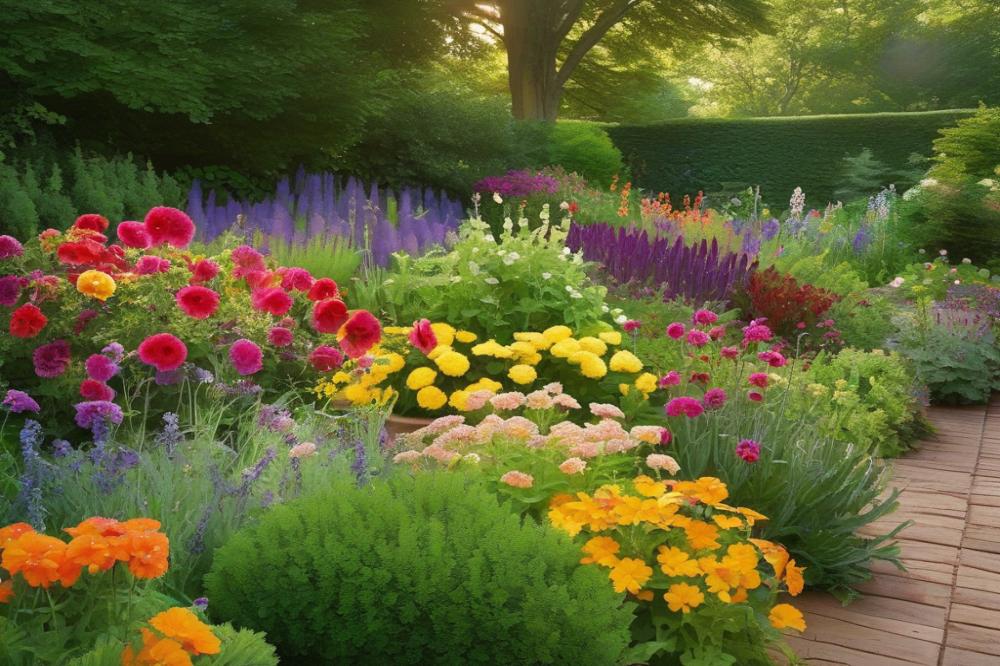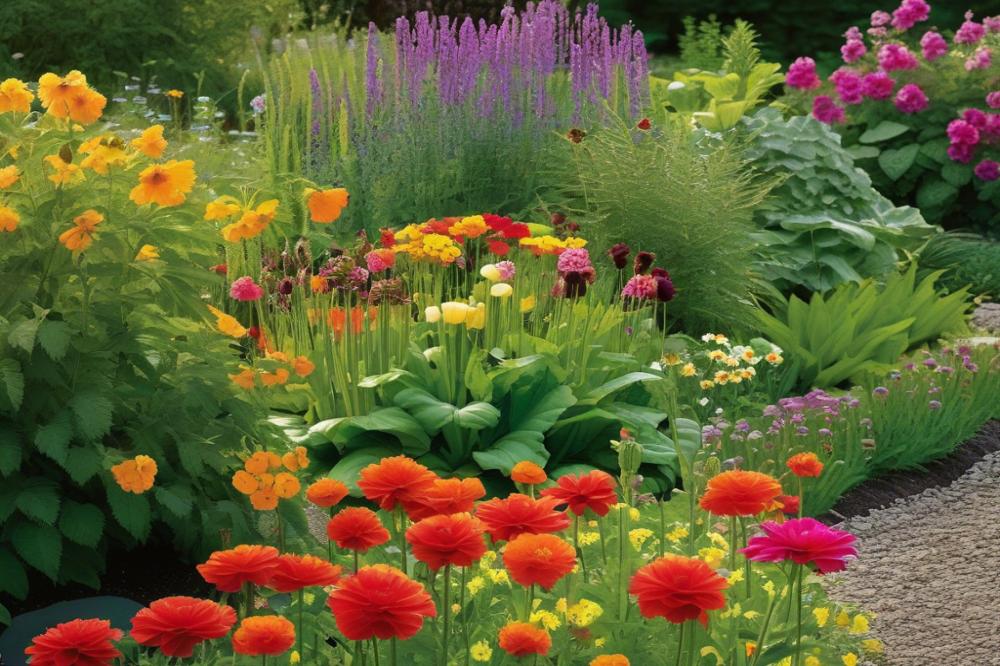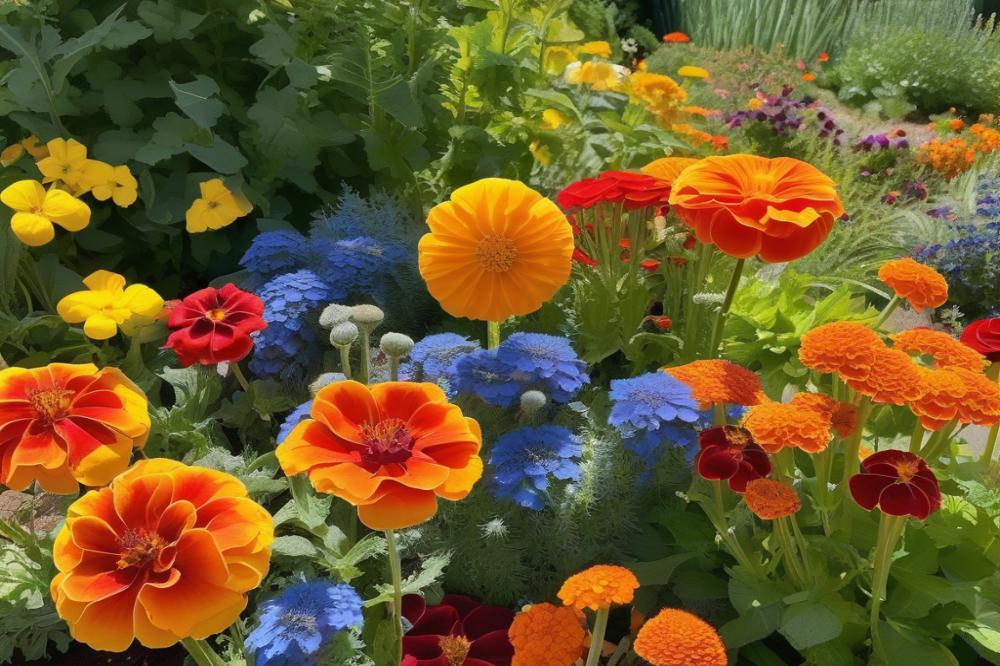The Role of companion flowers in Repelling Harmful Insects
companion flowers play a vital role in organic gardening. These colorful plants act as natural allies, enriching our gardens with both beauty and function. Their significance goes beyond aesthetics; they contribute to garden health and enhance biodiversity. In traditional gardening, chemical pesticides often pose risks to the environment. This has sparked a growing interest in sustainable gardening practices, emphasizing the need for natural pest control.
Natural repellents can effectively deter harmful insects while promoting a balanced ecosystem. Utilizing flower combinations is an age-old method that not only protects our crops but also attracts beneficial insects. These good bugs, like ladybugs and lacewings, are invaluable allies in maintaining a thriving garden. By encouraging biodiversity, gardeners can create an environment where pests are less likely to flourish.
Aromatic plants are among the most recognized in this context. Their strong scents naturally repel insects and can keep unwanted pests at bay. Many gardeners have found success using flower pairs to complement each other, creating a harmonious and effective pest management strategy. The synergy between different plant species fosters a thriving habitat that can sustain both plants and beneficial insects alike.
As we delve into the world of companion flowers, we will explore the various ways they combat harmful insects. This journey into ecological gardening reveals not just practical techniques, but also the beauty of nature working in concert. Understanding these interactions can empower gardeners to adopt more organic methods. In summary, companion flowers serve as powerful insect repellents while enriching our gardens. Exploring these roles opens up new possibilities for sustainable gardening.
Understanding Companion Flowers


Companion flowers play a significant role in gardens, serving multiple functions. They are plants grown alongside vegetables and herbs to help increase garden health. By incorporating these flowers, gardeners can create a more vibrant ecosystem.
Many of these blooms act as natural repellents. Certain varieties can deter harmful insects, minimizing the need for synthetic pesticides. This is a crucial aspect of organic gardening. By promoting these pest control methods, gardeners shift toward more sustainable practices.
One way these flowers enhance biodiversity is by attracting beneficial insects. Ladybugs and lacewings, for instance, are drawn to particular blossoms, such as marigolds and calendulas. These helpful insects prey on aphids and other pests, keeping populations in check.
Flower combinations can also lead to healthier plants. When certain flowers are paired with vegetables, they can improve growth and yield. For example, nasturtiums not only repel aphids but also attract pollinators. This creates a natural balance within the garden.
Aromatic plants, like lavender or rosemary, have additional benefits. Their scents can deter pests while also attracting helpful creatures. Many gardeners incorporate these varieties to promote ecological gardening principles.
Common companion flowers used in gardens include zinnias and sunflowers. Both flowers serve to attract pollinators while providing an aesthetic touch. Their presence contributes positively to overall garden health.
Ultimately, considering companion flowers in your gardening plan can lead to impressive results. These plants not only serve practical purposes but also add beauty to any space. Exploring diverse options can enhance your gardening experience.
The Science of Natural Repellents


Aromatic plants play a vital role in adding beauty and functionality to gardens. They contain essential oils that are often unpleasant to harmful insects. These oils serve as effective natural repellents. When planted alongside vegetables or other flowers, they can significantly enhance pest control.
Certain compounds found in flowers contribute to this effect. For instance, marigolds release a chemical called pyrethrum, known to deter nematodes and other garden pests. Similarly, the strong scent of basil can repel flies and mosquitoes. This natural strategy supports organic gardening by reducing the need for synthetic pesticides.
Attracting beneficial insects is another important aspect of using companion flora. Ladybugs and lacewings, for example, are often drawn to specific flower combinations. These beneficial insects help keep harmful populations in check. Healthy biodiversity in the garden not only creates a vibrant ecosystem but also enhances overall garden health.
Understanding how these relationships work fosters a deeper appreciation for ecological gardening. By planting specific flowers, gardeners can create a balanced environment. This approach reflects the principles of sustainable gardening, promoting harmony rather than conflict. Healthy gardens thrive when the right ingredients are in place.
Essential oils aren’t just for scents; they serve a higher purpose. When released into the air, their potent compounds disrupt the normal behavior of pests. This is especially helpful in gardens where chemical sprays could harm the ecosystem.
Incorporating companion plants brings a wealth of advantages. They can enhance growth and improve flavor in neighboring vegetables. Additionally, the visual appeal of a diverse garden is hard to beat. Many gardeners find joy in watching how flower interactions influence their plants.
Companion flowers act as a defense mechanism for the garden. By choosing the right plants, gardeners can take steps toward achieving healthier crops. Such practices ensure a thriving, pest-resistant environment that benefits all life forms. Through the lens of science, natural repellents reveal the interconnectedness of life in our gardens.
This combination of pest control strategies and fragrant blossoms underscores the importance of mindful planting. Knowing which plants repel pests helps gardeners make informed decisions. This awareness enriches the gardening experience, transforming it into a delicate dance of life and nature.
Effective Flower Combinations for Pest Control


Creating a thriving garden not only involves choosing the right vegetables and herbs but also pairing them with specific flowers that can deter pests. Flower combinations can be quite effective in maintaining garden health while enhancing biodiversity. Here are some practical pairings that work well together.
Marigolds and Vegetables
Marigolds are often praised for their ability to repel nematodes and other garden pests. When planted alongside tomatoes, peppers, or cucumbers, these bright flowers act as natural repellents against aphids and whiteflies. Their strong scent confuses harmful insects and encourages beneficial insects to thrive.
Nasturtiums as Trap Plants
Nasturtiums serve dual purposes in the garden. First, they attract aphids, keeping these pests away from other plants. Pairing these aromatic plants with your broccoli or kale can be a great strategy for organic gardening. The balance between attraction and repulsion supports overall garden health.
Lavender and Herbs
Lavender is not only beautiful but also effective in repelling mosquitoes and moths. When planted near herbs like basil or sage, it helps protect your herbs from pests while adding a lovely fragrance to the garden. This combination supports ecological gardening practices, fostering a healthier microenvironment.
Borage with Cucumbers
Borage flowers are beneficial companions for cucumber plants. They attract pollinators and beneficial insects such as predatory wasps, which prey on harmful bugs. Planting borage next to cucumbers can boost vegetable yield while naturally controlling pests.
Seasonal Considerations
Selecting flower combinations should consider seasonal changes. Cool-weather plants like pansies can be planted early in the spring, while heat-loving sunflowers thrive in summer. Tailoring your garden to seasonal dynamics helps maintain a habitat for beneficial insects year-round.
Planning Your Garden Layout
Thoughtful combinations can optimize pest control effectively. Grouping flowers with vegetables can create a screen for crops, making it difficult for pests to reach them. Consider creating clusters of flowers interspersed among vegetable rows. This layout not only enhances beauty but also strengthens plant communities.
Incorporating diverse flower combinations leads to sustainable gardening practices. Healthy ecosystems thrive on the presence of a variety of plants. Your garden can become a vibrant space that attracts beneficial insects, discouraging harmful pests without relying on chemical methods.
Overall, integrating specific flowers into your garden can yield significant benefits. Thinking about flower combinations allows gardeners to enhance pest control naturally while ensuring robust plant growth and a balanced environment.
Enhancing Biodiversity and Supporting Beneficial Insects


Biodiversity plays a crucial role in effective pest control. In a healthy ecosystem, numerous species coexist and support one another. When gardens are diverse, they become less vulnerable to pest outbreaks. This balance is key for maintaining garden health and productivity.
Companion flowers draw in beneficial insects that feast on harmful pests. These beneficial insects include ladybugs and lacewings, which are natural predators of aphids and mites. Aromatic plants, such as marigolds and mint, can also act as natural repellents, providing a dual benefit. Flower combinations are essential; they attract not just one type, but a variety of helpful insects. Pollinators like bees and butterflies thrive in these environments, promoting excellent flourishing plants.
Organic gardening practices emphasize the importance of a balanced ecosystem. Promoting biodiversity within your garden reduces reliance on chemical pesticides. When you create an inviting atmosphere for beneficial insects, you help cultivate a healthier environment. Each insect plays a specific role that contributes to sustainable gardening methods.
By planting a range of companion flowers, you can transform your garden into a sanctuary for various species. As these flowers bloom, they produce nectar and pollen, crucial food sources for many insects. This not only attracts pollinators, but also encourages predatory insects that keep pest populations in check. Incorporating diverse plant life allows nature to do much of the work for you.
In essence, the connection between flower diversity and garden health cannot be overlooked. Engaging in ecological gardening helps support a network of organisms that benefit each other. As beneficial insects flourish, they contribute to the overall vitality of the garden. It becomes evident that promoting biodiversity is an effective strategy for organic pest management.
Implementing Companion Flowers in Your Garden
Planting companion flowers can enhance garden health while providing pest control. Start by assessing your existing garden. Identify any local pest challenges. Understanding your region’s pest issues is crucial for choosing the right companion plants.
Many aromatic plants double as natural repellents. They can deter harmful insects while attracting beneficial insects. Marigolds, for example, repel nematodes and aphids. Nasturtiums attract aphids away from more valuable crops. Combining these flowers with vegetables can create a balanced ecosystem, improving biodiversity.
When planting, ensure you consider the growing conditions of each flower. Sunlight, soil type, and watering needs vary among plants. Grouping together those with similar requirements makes maintenance easier. A well-planned layout prevents overcrowding, allowing each plant to thrive.
Regular upkeep is important. Weeding, mulching, and watering should be routine. Healthy plants can better resist pest attacks. Consider organic gardening techniques to maintain soil health, which benefits all plants. Natural gardening methods lead to more sustainable results.
Experiment with various flower combinations. Interspersing flowers within vegetable rows creates visual appeal and practical functionality. Some gardeners find success with a “plant a row” method where flowers are alternated with crops. This not only looks nice but also promotes ecological gardening practices.
Monitor your garden regularly. Observing for signs of pests or disease will help in taking timely action. Natural deterrents can be your first line of defense before resorting to chemical methods. Remember, the goal is to create a space that thrives without harming the environment.
Talk to local gardening experts for tailored advice. They may have insights specific to your area. Many resources also exist in bookshops or online, focusing on pest control through companion flowers. Implementing these strategies can lead to a rewarding gardening experience.
Case Studies and Success Stories
Many gardeners have turned to aromatic plants to control pests in their vegetable patches. One case involved a small community garden in an urban area. The gardener planted marigolds alongside tomatoes and peppers. This combination worked wonders. The vibrant flowers attracted beneficial insects that preyed on common pests. With fewer aphids and whiteflies, the gardener reported a healthier crop and fewer insect-related issues.
Another successful story came from a homeowner who struggled with cabbage moths. After researching sustainable gardening practices, this individual decided to plant nasturtiums around their cabbage and kale. The bright colors of the nasturtiums not only added beauty but also deterred the cabbage moths. As a result, they enjoyed a bountiful harvest without the need for chemical pesticides.
A less common but fascinating example involved a flower combination of rosemary and beans. A gardener growing pole beans found that the strong scent of rosemary kept many unwanted insects away. By planting these two together, the garden flourished. There was an increase in biodiversity, as ladybugs and other beneficial insects began visiting regularly. This ecological gardening approach led to a more balanced ecosystem right in their backyard.
In coastal regions, homeowners faced challenges with slugs and snails. A few decided to plant geraniums as a natural repellent. The results were impressive. The flowers seemed to create an environment that slugs avoided. As the seasons passed, they noted a significant drop in the slug population. This change not only improved garden health but also made organic gardening more effective and enjoyable.
Success stories like these highlight the benefits of using flower combinations for pest control. These experiences show how gardeners can reduce pesticide usage while cultivating a thriving ecosystem. By choosing the right aromatic plants, they attract helpful insects that keep pests at bay. Each garden tells a story of resilience and ingenuity, proving that nature can be a powerful ally.
Wrapping Up the Benefits of Companion Planting
Utilizing flowers that work alongside crops can be a smart strategy for gardeners. This method plays a significant part in natural pest control. Numerous examples show that certain blooms repel harmful insects, reducing the need for chemicals. Such an approach fosters biodiversity, creating a balanced ecosystem within your garden.
Each plant contributes its own benefits. Some attract beneficial insects that prey on pests. Others release scents that deter unwanted visitors. This natural alliance between plants helps create a healthier environment. A garden filled with flowers not only looks beautiful but also acts as a fortress against pests.
Embracing companion planting can aid those aiming for sustainable gardening practices. Gardeners can reduce their reliance on harmful pesticides while promoting a vibrant habitat for various species. The overall impact leads to healthier plants and improved yields.
Consider this strategy as a key element in your gardening toolkit. By choosing the right combination of plants, you can enjoy both a fruitful garden and a safer environment. With thoughtful planning, growing flowers alongside your crops will yield numerous advantages.



